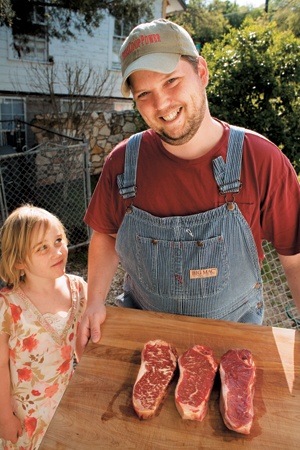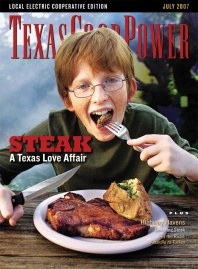My husband, Dave, doesn’t like to eat steak at a restaurant because he thinks he can do just as well at home with a good steak on the grill. I disagree, not because of his grilling ability, which is stellar, but because I like the ambiance of a steak house.
A real steak house serves its meat with pride and elegance. The surroundings, whether opulent or down-home, should make you feel a little like a cattle baron or baroness. The waitperson should set your dish down with pride, the steak commanding its place on the plate, unencumbered by too many side dishes or garnishes.
But although we differ in opinion on where to eat one, we both agree that the most significant detail is the quality of the steak. Choice is good, Prime is better (see sidebar), but what about that new darling of top chefs and aficionados, Kobe beef? It’s been praised for its succulent texture and superb taste, but it comes with a steep price tag.
What is Kobe Beef?
Here in Texas, there isn’t any real “Kobe” beef unless it’s been imported from the Kobe region of Japan. Rumors abound about how the Japanese cattle are treated, including regular massage and sake-soaked feed, but in Texas, the emphasis is on genetics and healthy cows.
Some Texas ranchers have imported the Japanese Wagyu (wahg-you) breed and crossbred it with Angus to create a hearty cow with more intramuscular fat, or “marbling,” than other U.S. breeds. Most Kobe-style beef is raised on a grain and grass diet, without hormones or antibiotics.
Even though there’s technically more fat, it turns out that it’s healthier fat. Stephen Smith, a researcher at Texas A&M University, found that Wagyu beef is higher in unsaturated fat and has higher levels of oleic acid (which lowers bad LDL cholesterol) than U.S. beef.
A&M researchers have also discovered that the U.S. Prime beef supply is not keeping up with consumer demand, leaving the market wide open for the super-rich Wagyu, even at its premium price. Consumer demand for Prime beef is around 9 percent, whereas only about 6 percent of the U.S. beef supply is graded Prime.
Put It to the Test
On a Friday afternoon, Texas Co-op Power staff and friends gathered to sample and rate different types of steak. We purchased a few each of Choice, Prime and Wagyu New York strips to compare. (The Choice and Prime were Certified Grass-Fed Angus purchased from Central Market; the Wagyu was from Yama Beef in East Texas.)
I respectfully asked Dave to follow the grilling directions of Fred Thompson, cookbook author and pit master (see facing page). He grilled the steaks to medium rare.
For most tasters, the biggest difference was between Choice and Prime. While all of us thought the Choice was good, and said we’d certainly serve it at home, we agreed that the Prime steaks were juicier, more tender and had a better overall flavor—definitely worth the price difference. The divide between Prime and Wagyu was more subjective, and split along gender lines. The men noticed a difference, particularly in flavor, but agreed that “for the price,” they liked the Prime better. The women said they could “taste the fat” in the Wagyu beef—in a good way. We found it more succulent and more flavorful. However, unless for a very special occasion, we agreed that our pocketbooks were more comfortable with the price of Prime.
In Fred Thompson’s newest book, Barbecue Nation (The Taunton Press, 2007), he has this to say about grilling steaks:
“Grilling a steak seems simple, but a few home truths need to be observed. Start with the best-quality meat. If you can find American-raised, grass-fed beef that’s Prime or aged, I urge you to purchase it. Look for good marbling: That’s the little white lines of fat running through the solid muscle of the meat. Remember that fat transfers flavor, so check your cholesterol fears at the door.
My recommendation is eat good red meat, just less often. When it comes to fuel, both charcoal briquettes and gas are fine, although you might want to give true hardwood charcoal a try. It burns hotter, which is what you want (most steakhouses are cooking at 800 degrees F plus). Also, the flavor from hardwood charcoal is clean, natural, and unadulterated. Season your steak very simply. Make sure the surface is dry except for a little oil. Wet beef won’t sear as well. I drizzle oil on my steaks to help the heat transfer begin—I get a better sear and more caramelizing, a 10-cent word for lots of flavor. Gild the lily at the end with butter, either a purchased seasoned butter or mix up your own. Plain unsalted butter is just fine as well.”
The Perfect Grilled Steak
4 well-marbled 1 1/2-inch-thick New York strip steaks, bone on if possible
Kosher salt to taste, about 1 teaspoon per steak
Freshly ground black pepper, about 1 teaspoon per steak
Olive oil (not extra virgin), as needed
1/4 cup (1/2 stick) unsalted or seasoned butter
Remove the steaks from the refrigerator at least 30 minutes before cooking.
Light a charcoal fire or preheat your gas grill on high. Oil the grill’s cooking surface.
Pat the steaks dry with a paper towel and sprinkle each on both sides with the salt and pepper, then drizzle with a light coating of olive oil. Put the grill grates in place and wait a few minutes as they heat. Place the steaks on the grill. Cook for a couple of minutes, until you can lift them up from the grill without sticking, then give each steak a quarter turn. Continue cooking for another couple of minutes, then flip the steaks over. So far they’ve cooked for 5 to 6 minutes. Grill for another 5 to 6 minutes on the second side.
Touch the meat to gauge its doneness* and remove or continue cooking. When done, remove the steaks to a platter, top each one with a pat of butter, then wait 5 minutes, giving the butter time to melt and the internal juices time to settle. Serve, pouring any melted butter and accumulated juices over the steaks.
*Checking for doneness without cutting: Touch your cheek. When you push on a steak and it feels like that, it’s rare. The tip of your nose is medium, and your forehead is well done. Timing helps, but feeling it in your fingertips is foolproof.


